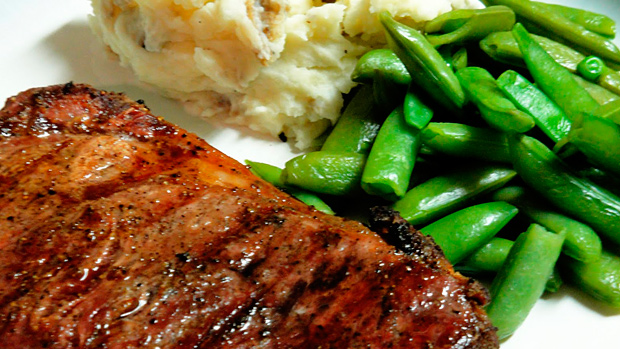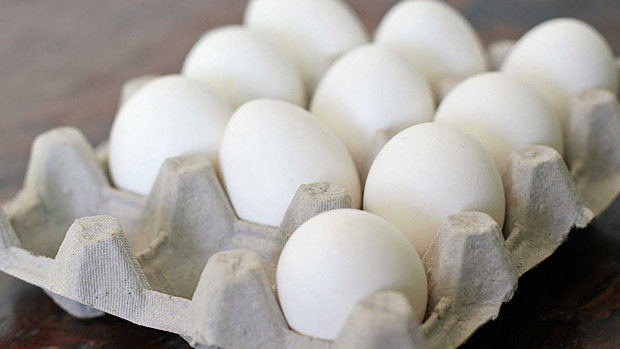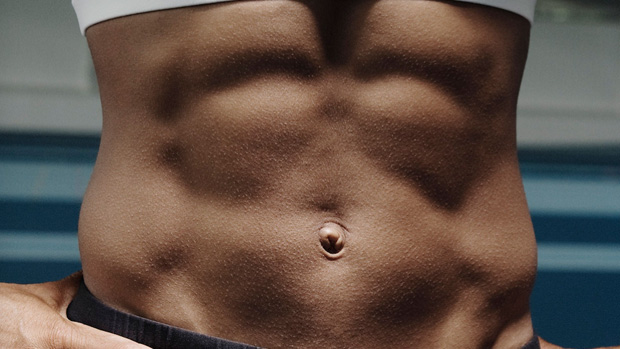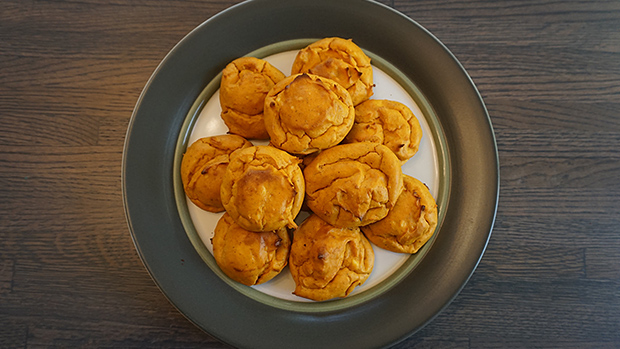With summer fast approaching, "beach-think" has set in and the current most popular question is, "Oh wise and mighty JB who knoweth and loveth the alimentary arts while abhorring all that is adipose, how might I battle my corpulence?" Okay, okay, it's more like, "Hey jackass, how do I get rid of my gut?" but a guy can dream of eloquent questions from glib readers, can't he?
Fed up with answering the gut question for the bazillionth time, this article was born. In fact, this article is the transcript from one of the lectures I recently gave at Ian King's excellent Bigger, Stronger, Leaner! seminar in Toronto. If you think it's time to bring out those abs for summer, then this is the article for you!
Last week, in Part I, I wrote about how all calories and all proteins aren't all equal, despite rights guaranteed to them by the Constitution. Carrying the argument further...
A Carbohydrate Is Not A Carbohydrate
In this section, I'd like to demonstrate that not all carbohydrates were created equal. Specifically, I'll briefly discuss:
- The insulin index vs. the glycemic index
- The superiority of low-GI and II diets
- The difference between liquid carbohydrates
While older carbohydrate classification schemes were centered on the notion of simple vs. complex carbohydrates (a structural classification), newer schemes focus more appropriately on the absorption profiles (glycemic index) and physiological effects (insulin index) of these carbohydrates (a functional classification).
The Glycemic Index (GI) is a classification scheme based on the blood glucose rise after consuming a carbohydrate food. This measure is based on the absorption profile of the food and was originally considered an indirect, but adequate measure of the insulin response to food. The assumption was that the insulin rise would be proportional to the glucose rise. However, recent research has demonstrated a dissociation of the glycemic response and the insulin response to the food. Therefore the insulin index was created.
The Insulin Index (II) is an index of the magnitude of insulin secretion as a result of food ingestion. Of course, this is the direct measure that the glycemic index could only approximate. Since insulin is a tricky hormone to manage, it's best to know exactly what's happening with this guy, especially if you have poor insulin sensitivity or poor carbohydrate tolerance.
Studies by Holt et al (1996) and Ostman et al (2001) highlighted some of these differences between glycemia and insulinemia. Interestingly, while the glycemic and insulin indices of many foods were similar, some foods caused unpredicted responses. As shown in the following graph, foods like yogurt and milk had relatively low-glycemic indices, but very high insulin indices. White and brown rice, on the other hand, had high-glycemic indices, but low insulin indices. The point here is that if you want to effectively manage body composition, you should choose your carbohydrates based on both the glycemic and insulin indices. Unfortunately, there are only limited insulin data out there, leading us to continue to rely in some cases only on the glycemic index.

More complete glycemic and insulin indices can be easily located by doing an Internet search on these two terms.
So the next appropriate question would be, "What does the literature say about low GI and II diets vs. higher GI diets?" Well, here's a summary:
Ludwig et al (2000) described the following list of benefits for eating a low GI diet:
- Better nutrition (better micronutrient profile and more fiber)
- Increased satiety
- Decreased hunger
- Lower subsequent energy intake (second meal effect)
- Fat loss
- Better fasted insulin and glucose
In a study by Agus et al (2000), it was demonstrated that during a short, 6 day, low-calorie diet, a low-GI carb intake preserved metabolism and enhanced fat loss vs. a high-GI diet. The low GI group saw a 5% decline in metabolic rate and a 7.7lb weight loss while the high-GI group saw an 11% decline in metabolic rate and a 6.6lb weight loss. In these subjects, fasted glucose and insulin values were lower in the low-GI group, indicating better glucose and insulin sensitivity.
Spieth et al (2000) and Ludwig et al (2000) showed that 4 months of low-GI eating was superior to 4 months of high-GI eating in overweight teens. The low-GI group lost 1.5 points on the BMI scale and 2.2 lbs while the high-GI group gained 2.88lbs and increased their BMI. In addition, these studies showed that a low GI meal reduced food intake during subsequent meals while the high GI meal lead to overeating.
Finally, Pawlak et al (2001) showed that in rats, a low-GI diet led to decreased fasting insulin and glucose values, decreased fat mass, and decreased insulin and glucose values during a glucose tolerance test. Therefore, body comp as well as glucose and insulin sensitivity improved.
The bottom line here is that when all else is equal, a diet containing mostly low-GI carbohydrates is superior to a high-GI diet for losing fat, preserving metabolic rate, and maintaining healthy insulin sensitivity and glucose tolerance.
Next, I'd like to illustrate the differences between popular liquid carbohydrates including maltodextrin, dextrose, fructose, and sucrose.
Maltodextrin is a glucose polymer (a string of glucose units put together, similar to the protein peptide). It is therefore, by definition, a complex carbohydrate. However it's more complex nature does NOT slow digestion. Therefore, the GI and II remain high. Maltodextrin is the absolute best carbohydrate to consume during exercise for rapidly delivering blood glucose and for muscle glycogen recovery. It's also best for fluid uptake.
Dextrose (glucose) is a simple carbohydrate unit (similar to the amino acid). While it's good for exercise situations (malto is better), you're probably better off adding some dextrose to your maltodextrin formula. A little bit of dextrose may enhance the already excellent fluid uptake that occurs with maltodextrin during exercise.
Fructose is a simple carbohydrate unit, but it's structurally different from glucose. Due to its structure, it can possibly cause GI problems and/or decrease fluid uptake with exercise. Fructose, unlike other simple carbs, has to be "treated" in the liver and it reaches the muscle slowly.
Finally, sucrose consists of glucose and fructose units bonded together. Therefore, upon digestion, you get glucose and fructose in the GI (and the benefits and consequences of each).
Based on the three studies I reviewed (Blom et al 1987, ven Den Burgh et al 1996, Piehl et al 2000), it appears that dextrose is 72% faster than fructose for muscle glycogen resynthesis . As a result, at the end of 8 hours, muscle glycogen was 30% higher with dextrose ingestion. However, in another study, at the end of 4 hours, muscle glycogen was 15% higher with maltodextrin ingestion vs. dextrose. So dextrose kicks fructose's butt although malto beats up on dextrose.
A Fat Is Not A Fat
In this section, I'd like to demonstrate that not all fats were created equal. Specifically, I'll briefly discuss:
- Fat Structure – Fatty Acid Chains and TGs
- MCTs – Medium Chain Triglycerides
- Olive Oil – Monounsaturated Fatty Acids
- CLA – Polyunsaturated Fatty Acids
- Fish Oil – Omega 3 Polyunsaturated Fatty Acids
As discussed in The Fat Roundtable, there are three different types of fatty acids; saturated (coming from animal fats), monounsaturated (coming from olive oil and avocados), and polyunsaturated (coming from flax oil, hemp oil, fish oil, canola oil, safflower oil, etc). Dietary fat, rather than simply floating around as free fatty acids, typically is packaged up in the form of a triglyceride. Basically, a triglyceride consists of 3 fatty acids (usually all of the same type) bound together by a glycerol backbone. Essentially, the glycerol backbone has 3 carbons and a fatty acid is attached (via a dehydration/synthesis reaction) to each of the 3 carbons.
Based on this structural phenomenon, scientists have recently begun exploring an interesting development in fat science. They've begun making "structured lipids." In essence what they're doing is making diacylglyerols (2 of the carbons have fatty acids attached while 1 does not) and special triacylglycerols (where there are fats of different lengths and properties attached to each carbon).
In clinical studies, these structured lipids have been shown to increase protein synthesis in patients suffering from wasting. In addition, these fats are easily oxidized (like the long chain fatty acids in fish oil) which leads to a thermogenic response rather than a storage response. As a result these structured lipids are now being heavily studied. While they're not on shelves yet, I wouldn't be surprised if these structured lipids become food additives in the near future.
MCT's and CLA, probably due to their early introduction to the weightlifting scene and the huge media hype associated with this introduction, have gotten a bad reputation. These fats may, in fact, assist in weight loss.
MCT's, due to their medium chain length, are easily oxidized by skeletal muscle. This is due to the fact that MCT's are quickly and easily transported to the fat furnace, the mitochondrion. As a result, research (Hill et al 1989) has demonstrated that TEF (thermogenic effect) with MCTs is double that of other fats, making it comparable to protein in this regard.
CLA has remained a relative mystery to the research community. This is probably due to the various forms (isomers) of CLA. Regardless, some research (Blankson et al 2000) has shown that 12 weeks of CLA supplementation (at doses above 3.4g/day) can increase LBM and decrease fat mass vs. olive oil. While the olive oil group gained 1.5 lbs of fat and no lean body mass, the CLA group lost 4.5 lbs of fat and gained 3 lbs of LBM.
Speaking of olive oil, even this "good fat" is better than saturated fat for body composition. In a study comparing safflower oil, beef fat, palm fat, and olive oil, it was shown that olive oil leads to a 14% higher oxygen consumption rate than the other fats.
Finally, if you've been around the T-mag community for a while you'll know that my favorite fats are those in fish oil. Delarue et al (1996) showed that fish oil supplementation (6g/day added to the diet) dramatically changed the metabolism of fats and carbohydrates.
During an OGTT (oral glucose tolerance test – drinking a big 75g whack of liquid sugar and measuring the subjects for 2 hours afterward), the fish oil group burned 27g of fat vs. 20g in the placebo group. The fish oil group also burned 28g or carbs while storing 36g and the placebo group burned 51g of carbs while storing only 14g.
In addition, baseline insulin was 30% lower in fish oil group and insulin responses to OGTT were 50% lower in the fish oil group. What this tells us is that fish oil allows the body to burn more fat and store more muscle glycogen, repartitioning fuel away from fat cells toward muscle cells.
Since fish oils are polyunsaturated fats, it's important to not only increase fish-oil intake, it's important to shift the ratio of polyunsaturated fat to saturated fat (P/S). Van Marken, Lichtenbelt et al (1997) showed that the polyunsaturated fat to saturated fat ratio is important to metabolic rate. A higher ratio of P/S leads to metabolic increases (22% increase in TEF and 3% increase in daily RMR).
So, if there's one thing you need to take from this discussion, I think it should be that, all else being equal, the fat composition (not just total intake) of your diet is very important to your body composition. Saturated fats, while necessary to a small extent, should only make up a small part of your diet while other fats like olive oil, fish oil, flax oil, MCTs, and CLA all have a place on your plate. This way you can get the same amount of daily energy from fats while gaining lean mass and without gaining body fat.
Choosing Your Food Wisely
So, with all the research out of the way, I hope that I've made a good argument for the fact that while total energy intake is important to energy balance, smart macronutrient choices go a very long way in shifting the energy balance equation in your favor. But to drive the point home, I'd like to give a living example of this fact.
One of my clients told me that he was a big fan of my work and my nutritional advice. However, he was convinced that his body simply couldn't get lean. The problem was that this gentleman got fat by using the calorie counting method. In fact, he used my very own Don't Diet method (the nerve of him!). He exercised regularly, training with weights 4x per week and doing daily cardio (mixing up interval exercise with endurance type exercise). In addition, he always ate about 500 calories below what his maintenance should have been. Yet he got fat anyway and was walking around at 25% body fat. He thought he was destined to be chubby forever.
So, was it true? Was he really fat loss resistant? Had my Don't Diet plan failed? I was perplexed so I had him write down everything he ate for a week. When sitting down with him a week later, the answer to his dieting woes was obvious. He was eating all the wrong foods. His diet was full of the media promoted fat free/super sugared/over processed/synthetic/bleached supermarket foods.
He believed that the foods he was choosing were good for him, but in fact, he was eating a diet designed for fat storage. When calculating the numbers, it worked out to be about 2,300 kcal at 30% protein, 50% carbs, and 20% fat. But the foods he used to make up these numbers were atrocious. He was eating way too much saturated fat, was drinking way too many whey protein shakes with milk, and was consuming too much sugar and processed, high-GI carbohydrate. There was very little natural fiber in his diet and he rarely ate vegetables or fruit. No wonder he couldn't lose weight!
Now, how on earth could he have believed that his diet was good? Well, although this data is a little old, I wanted to share it with you anyway because it's very telling about the power of marketing. In 1992 the National Cancer Institute spent $400,000 on an ad campaign to encourage the consumption of fruits and vegetables. That same year Kelloggs spent 32 million advertising Frosted Flakes alone! No wonder people don't know what foods are good for them!
So, back to the client. Well, it turns out that he had been down this road before. When he first started gaining weight, he decided to go on a diet program. He followed a ridiculous, muscle wasting, low calorie diet full of sweeteners and terrible tasting foods. And he lost some weight. But the minute he went back to eating what he thought was healthy and sensible (as described above); he gained all the fat back and then some!
So, now that I had him under my tutelage, what was the solution?
First I taught him where the produce aisle is. We gave him a list of the foods he could choose from. In addition, I taught him to combine his meals such that he was eating lean protein, good fats, and lots of fruits and veggies. We didn't count calories or pre-plan meals; we just made sure he had enough protein in the diet (200g). And guess what? Months later, he's still dropping fat while maintaining his lean mass. He's eating far more calories than he ever had before and enjoying meals more than he ever had before. In addition, he has a better health profile (blood chems) than before.
The bottom line is that diet isn't that hard. When you feed the body wholesome foods, the appetite regulates itself and you don't have to monitor very much. However, by harnessing the powers of good food selection and smart calorie counting, weight loss comes easy!
Here are some basic rules for how to improve your eating habits:
- Get used to the taste of food without dressings, sweeteners, etc. Ultimately you'll grow to like the natural taste of foods you once though tasted bland.
- Try to eat more like a true vegetarian (i.e. the bulk of the diet should come from fruits, veggies, unprocessed and unbleached food). But don't get me wrong; I don't want you swearing off meat.
- "Supplement" your unprocessed vegetarian-like diet with the high-protein foods discussed above.
- Add unheated healthy oils to your foods.
- Drink only calorie-free beverages (green tea, water, etc.).
- Unfortunately the worst foods usually are the most convenient and the most processed foods. Avoid eating for convenience alone.
- Avoid any easy-to-prepare breakfast foods (waffles, french toast, etc) as they're loaded with fattening trans-fatty acids.
- Avoid products containing the ingredients or words "partially hydrogenated," "high fructose corn syrup," etc.
- Avoid fast/fried food.
- Avoid foods or meals that are high in both fat and carbohydrate.
In addition to these rules, here's the list of food choices that I give to many of my clients. These foods should make up about 80% of your daily diet and, as indicated above, you should be eating many of these foods each day, not simply picking one or two selections to eat all the time.
Protein
- Fish: Salmon, Tuna, Cod
- Eggs
- Chicken breasts
- Cottage cheese
- Milk protien isolates
- Whey-casein blends
- Lean Red Meat
Carbohydrates
- Vegetables
- Mixed beans
- Low-GI fruits
- Oatmeal/Oat bran
- Mixed-grain bread
- Small amounts of protein-enriched pasta
Fats
- Flax oil
- EPA/DHA
- Olive oil
- Mixed nuts (no peanuts)
- Fish oil
For active individuals, the other 20% of your daily calories should come from the following sources (in order to enhance your recovery from intense exercise). The liquid meal should come during and after exercise while the second high-carb meal should come about 1-2 hours later.
Liquid meal (during exercise and immediately post exercise):
Protein: Plazma™
Carbohydrates: Mag-10®
Solid meal (2 hours post exercise):
Protein: Plain yogurt
Carbohydrate: High GI, solid-fiber cereal
In addition, here's the other list that I give to my clients. These are foods to avoid at all costs:
Proteins
- Fatty meats
- Fatty dairy
- Most lunch meat
- Large amounts of milk
- Large amounts of soy
Carbohydrates
- Regular bread
- Added sugar
- Most cereals
- Soda
- Fruit juice
- Bagels
- Fruit bars
- Candy
Fats
- Margarine
- Vegetable oil
- Corn oil
- Heated/fried oil
In conclusion, food selection is one of the more important determinants of your body composition. Using the rules above, you can make your fat loss quest much easier than you ever imagined!





